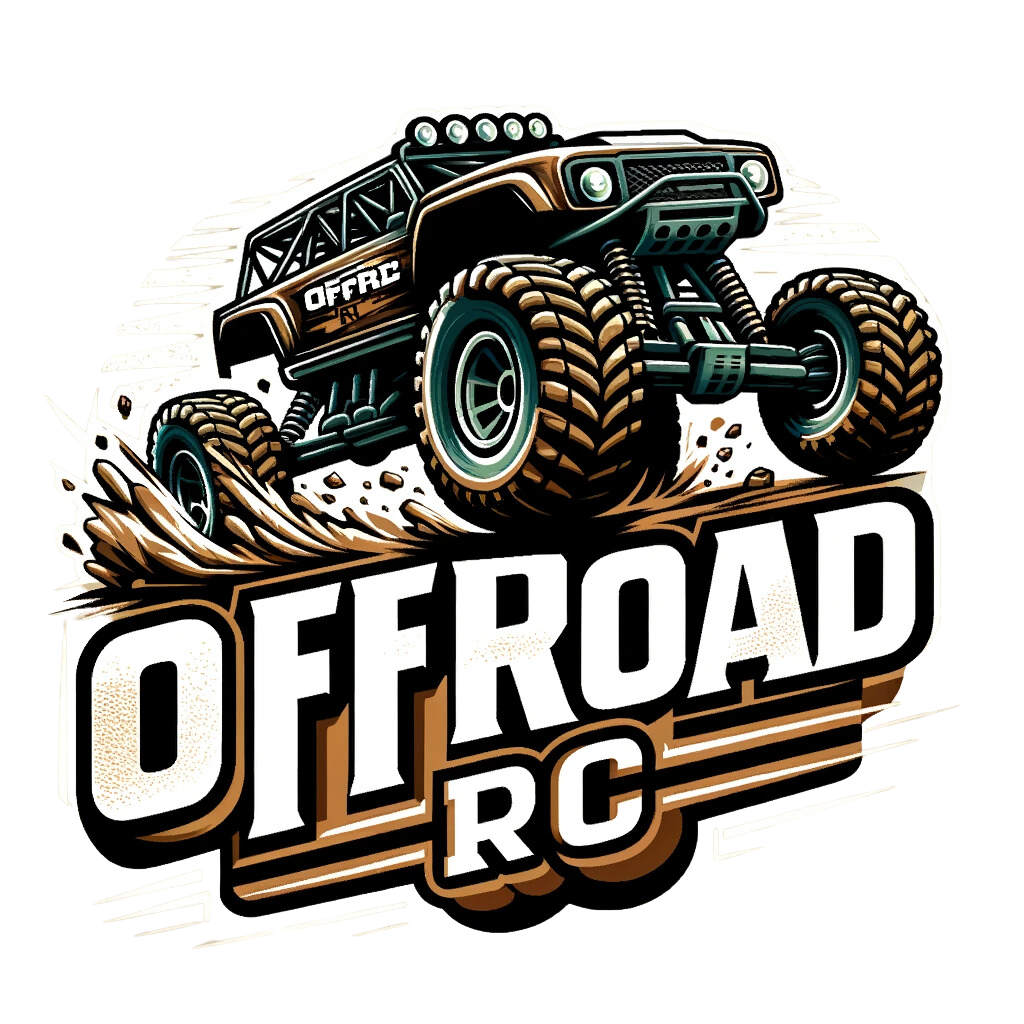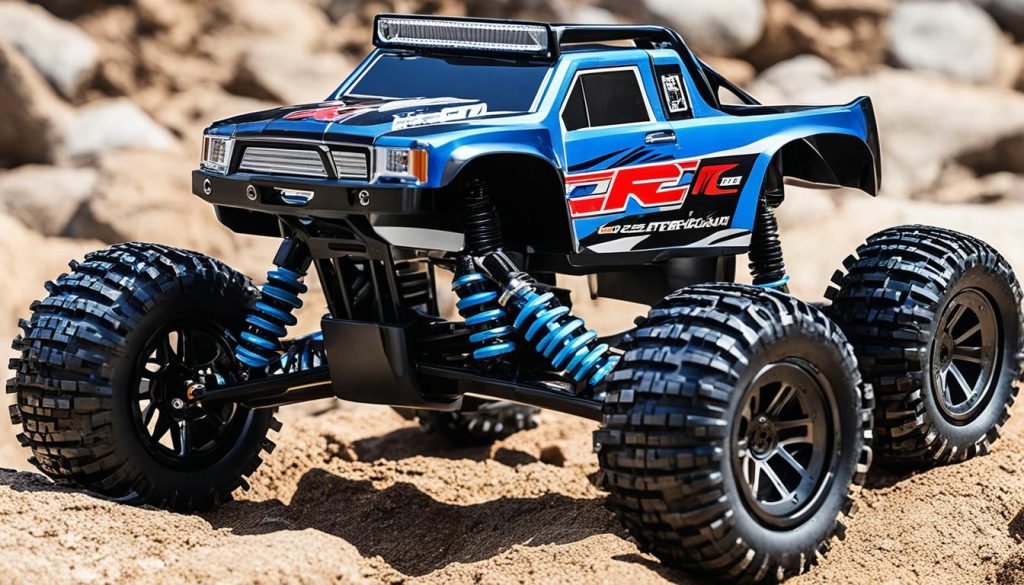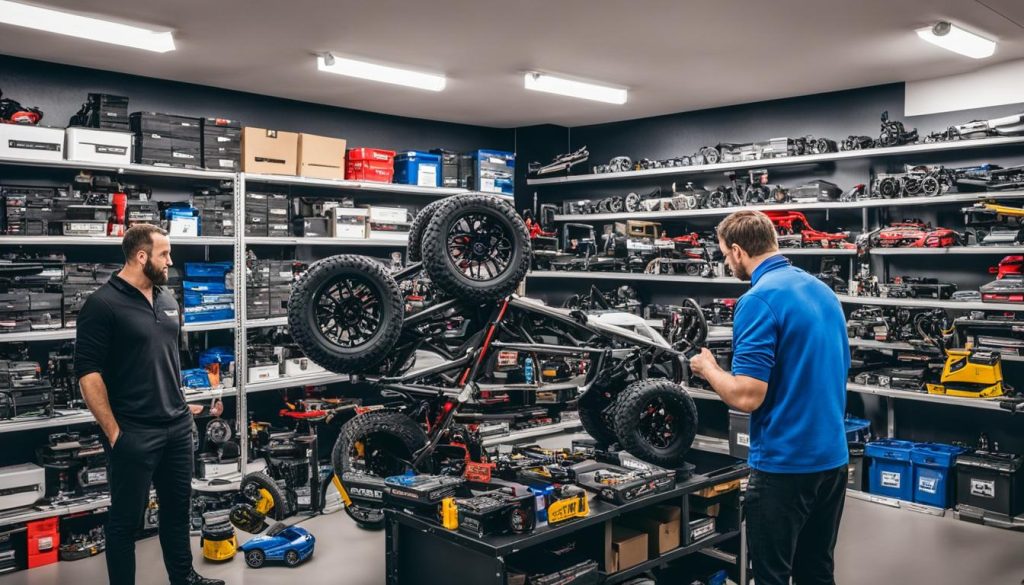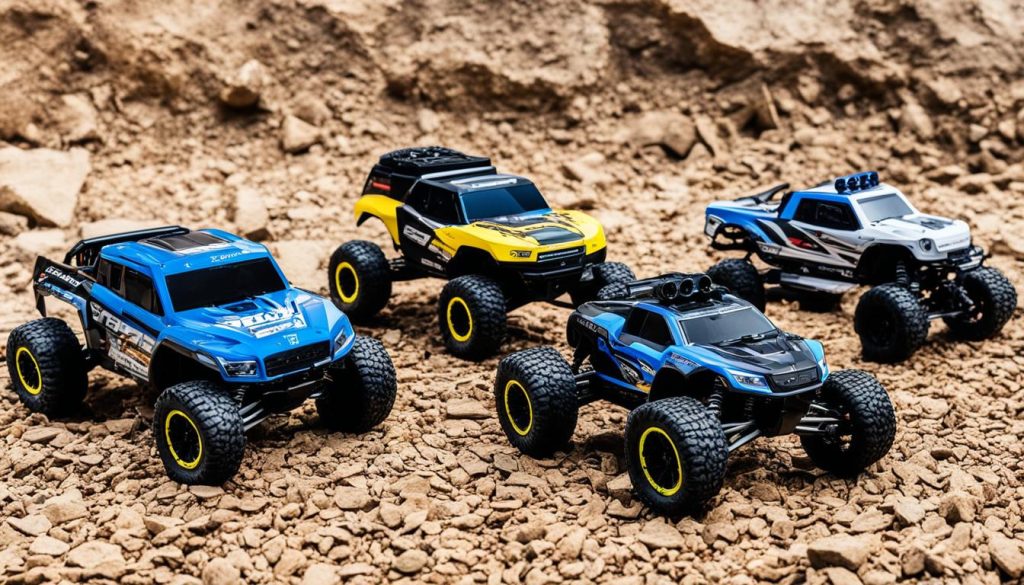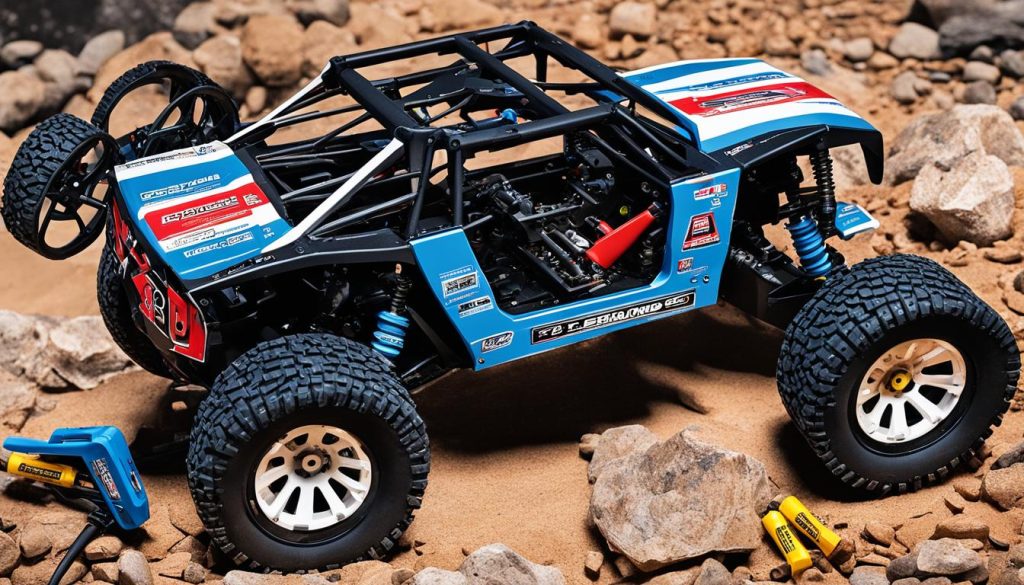Off-road RC cars are built with various components that are essential for their performance on tough terrains. These components include the chassis, suspension, tires, body, and electronics. Each part plays a vital role in ensuring the car’s durability, stability, and maneuverability.
Key Takeaways:
- The chassis, suspension, tires, body, and electronics are essential parts of an off-road RC car.
- The chassis provides structural support and determines the car’s stability and handling.
- The suspension system absorbs shocks and vibrations from uneven terrains.
- Off-road RC car tires have deep treads and a durable rubber compound for traction and stability.
- The body protects internal components and adds to the car’s appearance.
- The electronics control the car’s speed, steering, and other functions.
- Some off-road RC cars are powered by nitro engines for increased speed.
Chassis
The chassis is the framework that holds all the components of an off-road RC car together. It provides structural support and determines the car’s overall stability and handling. Off-road RC car chassis are typically made from lightweight and durable materials like aluminum or composite materials to withstand the rigors of off-road driving. The design of the chassis can vary depending on the specific type of off-road RC car, such as a buggy, truck, or crawler.
The off-road RC car chassis plays a crucial role in the car’s performance and durability. Its construction and material selection are designed to handle the demanding conditions of off-road driving. By using lightweight and strong materials like aluminum, the chassis provides the necessary support while minimizing weight, thus enhancing the car’s agility and maneuverability.
The design of the chassis also contributes to the car’s stability and handling. For example, a buggy chassis is typically designed to be low and sleek, optimizing aerodynamics and reducing wind resistance. This design allows the car to maintain higher speeds while navigating through rough terrains.
On the other hand, a truck or crawler chassis is often designed with a higher ground clearance to tackle obstacles and uneven surfaces. The higher chassis allows for better suspension travel and articulation, ensuring that the wheels can maintain constant contact with the ground for improved traction and control.
In summary, the chassis is a crucial component of an off-road RC car, providing the necessary support and stability to handle the challenges of off-road driving. Its design and construction play a significant role in determining the car’s performance and agility. By choosing a well-designed and durable chassis, RC car enthusiasts can enjoy the excitement of off-road driving with confidence.
Suspension
The suspension system in an off-road RC car is a crucial component that ensures a smooth and controlled ride over uneven terrains. It plays a vital role in absorbing shocks and vibrations, maintaining traction, stability, and control. The suspension system consists of several key components, including shock absorbers, A-arms, and suspension links.
Shock absorbers, also known as dampers, are responsible for dampening the impact of bumps and jumps. They control the movement of the suspension and help keep the tires in contact with the ground, improving traction. A-arms, or wishbones, connect the suspension components to the chassis and allow the wheels to move up and down independently. Suspension links, also known as tie rods, are responsible for maintaining the alignment and geometry of the suspension system.
Off-road RC cars employ different types of suspensions to suit various terrains and driving styles. Independent suspension allows each wheel to move freely, providing better traction and handling on rough terrains. Solid axle suspension, on the other hand, offers greater durability and stability, making it suitable for extreme off-roading.
“The suspension system is a critical aspect of off-road RC cars, ensuring maximum performance and control on challenging terrains.” – RC Car Enthusiast
Suspension Types
Off-road RC cars feature different types of suspensions depending on their intended use:
- Independent Suspension: This type of suspension allows each wheel to move independently, improving traction, stability, and overall performance on uneven terrains.
- Solid Axle Suspension: Solid axles connect both wheels on an axle, providing excellent durability and stability, making it ideal for extreme off-roading and crawling.
Each suspension type has its advantages and is designed to meet specific off-road challenges. It’s essential to choose the suspension type that best suits your driving style and the terrain you’ll be navigating.
| Suspension Type | Advantages | Disadvantages |
|---|---|---|
| Independent Suspension |
|
|
| Solid Axle Suspension |
|
|
Tires
When it comes to off-road RC cars, the tires play a crucial role in determining performance on rough terrains. Designed specifically for off-road driving, these tires are built with features that provide optimal traction and stability.
The deep treads on off-road RC car tires are designed to grip various surfaces such as mud, rocks, and sand. This allows the car to maintain traction and maneuver through challenging terrains with ease. Additionally, the durable rubber compound ensures longevity, allowing the tires to withstand the rigors of off-road driving.
Furthermore, off-road RC car tires can be customized to match specific terrains. Whether you’re facing muddy conditions, rocky terrains, or sandy landscapes, there are tire treads available to optimize performance in each scenario.
The size and diameter of the tires also contribute to the car’s ground clearance and overall performance. Larger tires can increase ground clearance, allowing the car to navigate over obstacles more effectively. Additionally, the size and diameter of the tires impact the car’s stability and control.
Overall, choosing the right tires is essential for achieving optimal performance and control in off-road RC car driving. By investing in high-quality, specialized tires, you can enhance your RC car’s capabilities on rough terrains and enjoy an exhilarating off-road experience.
| Tire Features | Benefits |
|---|---|
| Deep treads | Enhanced traction on rough terrains |
| Durable rubber compound | Longevity and resistance to wear and tear |
| Customizable treads | Optimized performance on specific terrains |
| Varying sizes and diameters | Impact on ground clearance, stability, and control |
Body
The body of an off-road RC car serves both functional and aesthetic purposes. It provides protection for the internal components and adds to the car’s overall appearance. Off-road RC car bodies are usually made from lightweight polycarbonate material, which is resistant to impacts and can be easily customized with paint or decals.
The body design can vary depending on the type of off-road RC car. Some models feature fender flares that provide extra protection and improve the car’s off-road capabilities. Others have roll cages to enhance structural integrity during high-intensity driving. Additionally, aerodynamic elements may be incorporated into the body design to optimize speed and stability on challenging terrains.
If you want to make your off-road RC car stand out, you can customize the body with vibrant paint schemes or add decals that reflect your personal style. This allows you to express your creativity and make your car unique among other enthusiasts.
“The body of an off-road RC car not only adds protection but enables personalization and allows you to stand out among other enthusiasts.”
Features of Off-Road RC Car Body Designs:
- Fender flares for added protection
- Roll cages for enhanced structural integrity
- Aerodynamic elements for improved speed and stability
Benefits of Customization:
- Express your creativity
- Make your off-road RC car unique
- Reflect your personal style through vibrant paint or decals
| Pros | Cons |
|---|---|
| Lightweight and impact-resistant | Can be prone to scratches |
| Easily customizable with paint or decals | May require additional maintenance for longevity |
| Offers protection for internal components | Customization may add additional cost |
| Allows for unique and personalized designs |
Electronics
In the world of off-road RC cars, the electronics play a crucial role in delivering precise control and high performance. These intricate components work together seamlessly, ensuring your car responds with lightning-fast speed and accuracy. Let’s dive into the key electronics found in off-road RC cars:
Motor
The motor is the heart of your off-road RC car, responsible for providing the power needed to conquer any challenging terrain. Brushless motors, renowned for their efficiency and power, are commonly used in off-road RC cars. With their impressive torque and RPM limits, these motors offer exceptional acceleration and top-end speed, allowing you to leave your competitors in the dust. The advanced design ensures smooth and reliable performance, while also tending to be more durable compared to brushed motors.
ESC – Electronic Speed Controller
The Electronic Speed Controller, or ESC, acts as the command center for your off-road RC car. It regulates the power flow from the battery to the motor, determining the speed and acceleration of your car. ESCs are equipped with advanced features such as programmability, allowing you to fine-tune the performance characteristics to match your driving style. Waterproof ESCs are also available, adding an extra layer of protection against moisture and making your car suitable for all-weather adventures.
Receiver and Transmitter
The receiver is the component that receives the signals transmitted by your remote controller or transmitter. It relays these signals to the appropriate electronic components in your off-road RC car, allowing you to steer, accelerate, and control various functions. Transmitters provide precise control over your car’s movements, ensuring quick response times and minimal latency. Many off-road RC car enthusiasts prefer transmitters with advanced features like multiple channels, ergonomic designs, and telemetry capabilities.
Servos
Servos are small but mighty components that control the steering and other moving parts of your off-road RC car. These compact motors convert the electrical signals received from the receiver into mechanical movements, allowing you to navigate tight corners, maneuver challenging obstacles, and perform impressive stunts. With their precision and torque, servos play a vital role in ensuring your off-road RC car responds to your commands instantly and accurately.
Waterproofing and Programmability
In the world of off-road RC car electronics, waterproofing and programmability are highly sought-after features. Waterproof electronics offer added protection against moisture and allow you to take your car through wet, muddy, or even snowy terrains without worrying about damage. Programmability allows you to customize various parameters of your car’s electronics, such as throttle curve, brake strength, and drag brake limits, to optimize performance and suit your preferences. With programmable ESCs and transmitters, the possibilities for fine-tuning your off-road RC car are virtually limitless.
Image:
| Component | Function |
|---|---|
| Motor | Provides power to the off-road RC car for speed and acceleration. |
| ESC | Regulates power flow from the battery to the motor, controlling speed and acceleration. |
| Receiver | Receives signals from the transmitter and relays them to the appropriate components. |
| Transmitter | Controls the steering, acceleration, and other functions of the off-road RC car. |
| Servos | Convert electrical signals into mechanical movements to control steering and other parts. |
| Waterproofing | Protects electronics from moisture, allowing for all-weather adventures. |
| Programmability | Customize electronic parameters for optimal performance and personal preferences. |
Nitro Engine
While many off-road RC cars are powered by electric motors, some enthusiasts prefer the thrill and power of a nitro engine. Nitro engines use a combustion process with a fuel mixture of methanol, nitromethane, and oil, providing a unique experience for RC car enthusiasts.
Compared to electric motors, nitro engines offer a few distinct advantages. One of the key attractions is the realistic sound they produce, imitating the roar of a full-sized engine. This adds to the excitement and immersion of off-road RC car racing.
Another advantage of nitro engines is the increased speed they can achieve compared to electric motors. The combustion process generates more power, allowing nitro-powered RC cars to reach impressive speeds on the track or off-road terrain.
Nitro engines come in different sizes, indicated by their displacement size in cubic inches. Some common sizes include .12, .15, .21, and .28, with larger engines typically found in monster trucks for maximum power and performance.
Benefits of Nitro Engines:
- Realistic sound for an immersive experience
- Increased speed compared to electric motors
- Wide range of engine sizes for different RC car types
If you’re seeking the authentic sound and exhilaration of a combustion engine, a nitro-powered RC car with a nitro engine might be the perfect fit for you. Just be sure to follow proper fuel mixing and maintenance guidelines to keep your nitro engine running smoothly and efficiently.
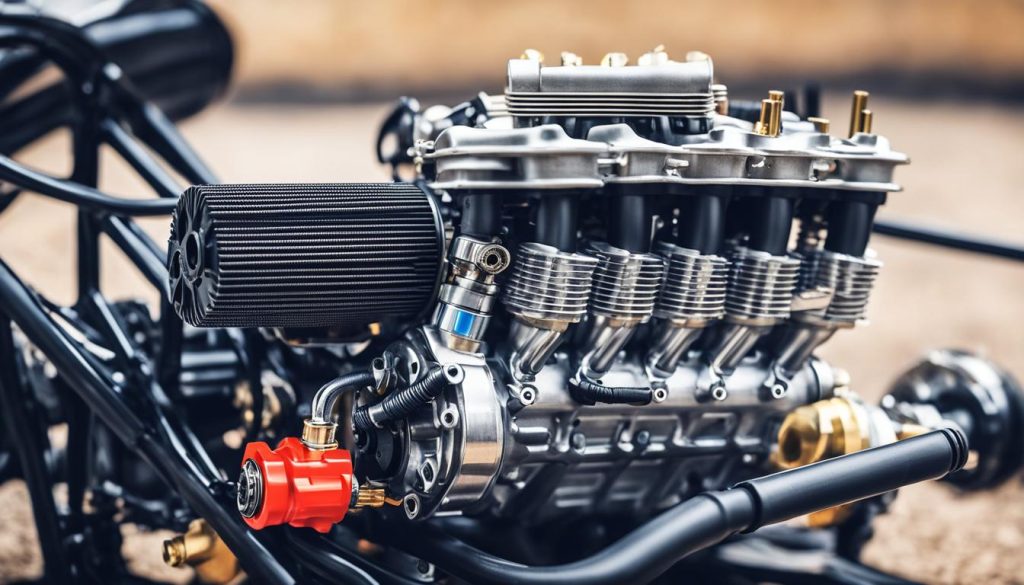
Drive Type
When it comes to off-road RC cars, one of the key considerations is the drive type. You have two options: 2-wheel-drive (2WD) or 4-wheel-drive (4WD). Each drive type offers distinct advantages and caters to different preferences and driving styles.
A 2WD off-road RC car delivers power to the rear wheels only. This configuration makes it less complex, more affordable, and easier to maintain. 2WD cars are popular among beginners or those who prefer a simpler setup. However, it’s important to note that 2WD cars may face more challenges when navigating rough or difficult terrains due to reduced traction.
On the other hand, a 4WD off-road RC car distributes power to all four wheels, providing improved traction and stability. This configuration offers enhanced performance, particularly in challenging terrains such as mud, rocks, or steep inclines. 4WD cars deliver better control and increased torque, making them suitable for more experienced drivers or those seeking to tackle off-road obstacles with ease.
The choice between 2WD and 4WD ultimately depends on your intended use and personal preference. If you prioritize simplicity and cost-effectiveness, a 2WD RC car may be the right option for you. However, if you crave better traction and performance on demanding terrains, a 4WD RC car is likely a better fit.
Key Takeaways
- Off-road RC cars can be classified as either 2-wheel-drive (2WD) or 4-wheel-drive (4WD).
- A 2WD configuration powers the rear wheels only, while a 4WD configuration distributes power to all four wheels.
- 2WD cars are typically more affordable and easier to maintain, while 4WD cars offer better traction and performance on challenging terrains.
- The choice of drive type depends on your intended use and personal preference.
Radio System
The radio system is a crucial component of an off-road RC car, providing the means for remote control and precise maneuvering. It consists of the transmitter, receiver, and servos, working together to ensure seamless communication between the driver and the car’s electronics.
With the transmitter in hand, the driver sends signals to the receiver, which is connected to the car’s electronics. The receiver interprets these signals and controls the servos, which are responsible for operating the car’s steering and other functions.
The radio system enables you to control your off-road RC car from a distance, allowing you to navigate through challenging terrains with ease and precision. Whether you’re racing, rock crawling, or exploring off-road trails, a reliable and responsive radio system is essential for maintaining control and achieving the desired performance.
| Component | Description |
|---|---|
| Transmitter | The handheld device held by the driver to send signals to the receiver. |
| Receiver | The component connected to the car’s electronics that interprets the signals from the transmitter. |
| Servos | Actuators that receive signals from the receiver and control the car’s steering and other functions. |
Battery
Electric off-road RC cars require a RC car battery to power the motor and electronics. Typically, a rechargeable pack made of lithium-ion or nickel-metal hydride cells is used as the power source. The capacity and voltage of the battery are crucial factors that determine the car’s runtime and performance. Higher-capacity batteries offer longer runtimes but may add weight to the car.
It’s important to have proper off-road RC car battery charging systems and battery management techniques to maintain the battery’s lifespan and performance. This ensures optimal power output and prolongs the overall battery life.
Battery Options:
- Lithium-ion battery pack: Provides a lightweight and high-capacity option for extended runtime.
- Nickel-metal hydride battery pack: Offers a reliable and affordable solution with a lower capacity compared to lithium-ion batteries.
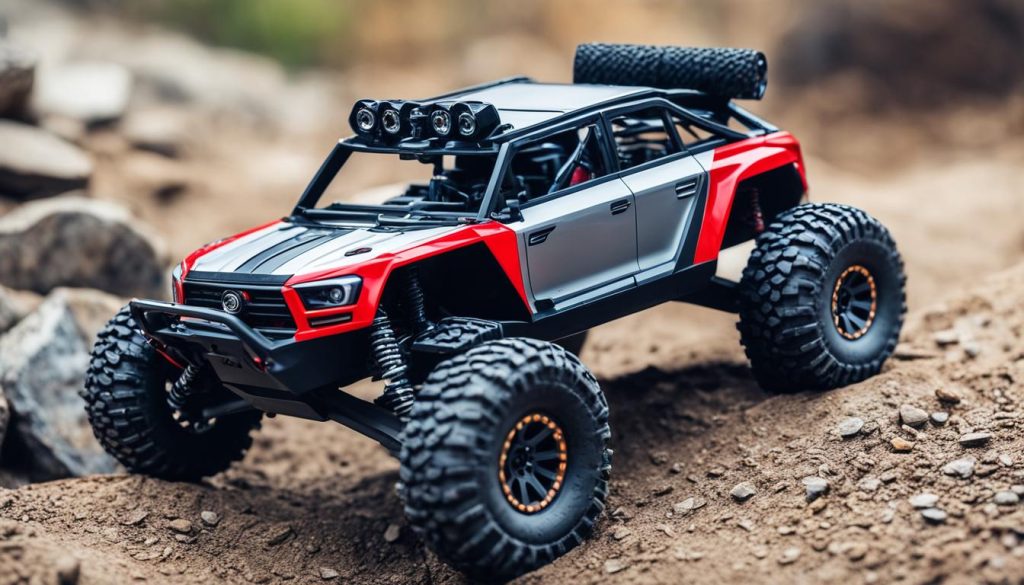
Battery Management Tips:
- Use a compatible charger specifically designed for the type of battery used in your RC car.
- Follow the manufacturer’s guidelines for charging and discharging the battery to avoid damaging it.
- Ensure proper storage of the battery when not in use to prevent degradation and maintain its performance.
Having a reliable and well-maintained RC car battery is essential for powering your off-road adventures. Choose the right battery for your needs and ensure proper charging and maintenance to maximize performance and enjoy longer runtimes.
Accessories and Upgrades
Enhance the performance and customization of your off-road RC car with a wide range of accessories and upgrades. These accessories and upgrades allow you to optimize your vehicle for specific terrains and driving styles, taking your RC car experience to the next level.
Upgrade your motors for increased power and speed, giving your off-road RC car a competitive edge on the track. Replace stock ESCs (Electronic Speed Controllers) with high-performance options to enhance throttle response and overall control. Upgrade suspension components, such as shocks and springs, to better absorb shocks and provide improved traction on rough terrains.
Choose off-road RC car tires designed for the specific terrain you’ll be driving on. From aggressive tread patterns for muddy tracks to reinforced sidewalls for rock crawling, there are tire options available to match any off-road challenge you may face. Upgrade your RC car body with aerodynamic features, stylish designs, and durable materials like polycarbonate to personalize your vehicle’s appearance.
Don’t forget about the electronics that power your off-road RC car. Upgrade your receiver and transmitter for enhanced range and signal clarity, ensuring precise control even at a distance. Consider upgrading your servo for faster and more precise steering response, allowing you to navigate tight corners with ease.
Here are some popular off-road RC car accessories:
- Battery chargers to keep your RC car powered up and ready for action.
- Tools for maintenance and repairs, ensuring your car performs at its best.
- Carrying cases and bags to safely transport your RC car to different locations.
- Maintenance supplies like lubricants and cleaning solutions to keep your car in top condition.
“With the right accessories and upgrades, you can tailor your off-road RC car to your preferences and conquer any terrain with confidence.”
Investing in accessories and upgrades allows you to unlock the full potential of your off-road RC car, making it a powerful and customized machine that suits your specific needs. Explore the options available and take your RC car adventures to new heights.
| Accessories | Benefits |
|---|---|
| Upgraded Motors | Increased power and speed for enhanced performance |
| High-Performance ESCs | Improved throttle response and control |
| Suspension Components | Better shock absorption and traction on rough terrains |
| Specialized Tires | Enhanced grip and stability on specific terrains |
| Custom RC Car Bodies | Personalized appearance and aerodynamic features |
| Upgraded Receivers and Transmitters | Extended range and precise control |
| Enhanced Servos | Faster and more precise steering response |
Conclusion
In conclusion, off-road RC cars are an exhilarating hobby that requires a deep understanding of their essential components and functionalities. The RC car chassis forms the backbone of the vehicle, providing stability and support. A well-designed suspension system ensures smooth rides over challenging terrains by absorbing shocks and vibrations. The right set of RC car tires offers optimal traction on various surfaces, while a durable and customizable body protects the internal components and adds flair to the car’s appearance.
The RC car electronics, including the motor, ESC, receiver, transmitter, and servos, are essential for controlling the car’s speed, steering, and other functions. For those seeking a realistic experience, nitro engines provide a powerful and engaging option. The choice between 2-wheel-drive and 4-wheel-drive depends on the driver’s preferences and the desired level of performance on the off-road track.
Furthermore, the off-road RC car radio system allows for seamless remote control and precise maneuvering. The car battery, whether a rechargeable pack or nitro fuel, determines the runtime and performance of the vehicle. To further enhance performance and customization, various accessories and upgrade options, such as motors, ESCs, suspension components, and tires, are available in the market.
By understanding the role and functionality of each component and exploring the available customization options, RC car enthusiasts can optimize their off-road driving experience and enjoy thrilling adventures on the toughest terrains. So, get ready to fuel your passion for off-road RC cars and embark on unforgettable journeys with these powerful and versatile machines.
FAQ
What are the basic components of an off-road RC car?
The basic components of an off-road RC car include the chassis, suspension, tires, body, and electronics.
What is the function of the chassis in an off-road RC car?
The chassis provides structural support and determines the car’s stability and handling.
What is the role of the suspension system in an off-road RC car?
The suspension system absorbs shocks and vibrations from uneven terrains and ensures traction and control.
How do off-road RC car tires differ from regular tires?
Off-road RC car tires have deep treads and a durable rubber compound for enhanced grip and stability on rough terrains.
What is the purpose of the body in an off-road RC car?
The body provides protection for internal components and adds to the car’s aesthetics.
What components are included in the electronics of an off-road RC car?
The electronics of an off-road RC car consist of the motor, ESC, receiver, transmitter, and servos.
What is a nitro engine in an off-road RC car?
A nitro engine is an alternative to electric motors and uses a fuel mixture for increased speed and realistic sound.
What is the difference between 2-wheel-drive and 4-wheel-drive in off-road RC cars?
2-wheel-drive cars power the two rear wheels, while 4-wheel-drive cars distribute power to all four wheels for better traction and performance.
What is the radio system in an off-road RC car?
The radio system includes the transmitter, receiver, and servos, allowing remote control and precise maneuvering of the car.
What type of battery does an electric off-road RC car use?
Electric off-road RC cars use rechargeable batteries, often made of lithium-ion or nickel-metal hydride cells.
Can off-road RC cars be customized and upgraded?
Yes, off-road RC cars can be customized and upgraded with accessories and aftermarket parts to enhance performance and personalization.
What are the essential components in building an off-road RC car?
The essential components in building an off-road RC car include the chassis, suspension, tires, body, electronics, and battery.
Source Links
- https://www.competitionx.com/rc-glossary/
- https://www.solarpaneltalk.com/forum/off-grid-solar/12v-solar-for-rv-or-camping-etc/420800-solar-panel-charger-for-rc-model-car-batteries
- https://outbackjoe.com/macho-divertissement/macho-articles/design-guide-for-12v-systems-dual-batteries-solar-panels-and-inverters/
